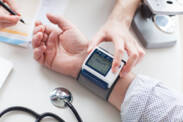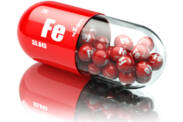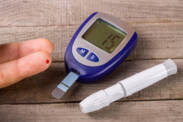Cardiovascular and lymphatic system

The Island
Swelling is a common symptom of various diseases or health problems. It occurs in diseases of the blood vessels, heart, but also in many skin and metabolic problems, as well as in injuries. It can be a generalized swelling that occurs throughout the body. Or it can be a local swelling that affects only a certain part of the body. Professionally, swelling is referred to as edema.

Low blood pressure
Low blood pressure is a condition where the blood pressure falls below 100/60. Professionally, it is also called hypotension. Its cause is not fully understood. Sometimes it arises as a consequence of another disease.

Slowed heartbeat
A slow heartbeat is referred to as bradycardia. It is divided into physiological (when its cause is not a disease) and pathological (which is already a symptom of a disease).

Increased iron levels in the blood
Iron is essential for life. When it is deficient and also in excess, a health problem can arise. Its excess can be caused by increased intake in the diet. But it also arises in disease states and illnesses, for example, in liver damage.

Increased blood sugar levels
Hyperglycaemia is a problem mainly with diabetes. Blood sugar levels are higher, which causes other problems. Like vision, nervous system. But it's not just diabetes. It's also caused by other diseases.

Accelerated heart rate
We don't normally feel our heartbeat. When the heart rate increases, the heart rate increases. And in certain circumstances, it's noticeable. It increases with increased physical or mental exertion. But often, the increase is due to disease.

Heart enlargement
In an athlete, this is a normal condition, when the heart has become accustomed to the increased need for blood supply to the muscles and the body. Another case is if the cause is a disease. It may be a problem with the cardiovascular, respiratory system. Heart enlargement also occurs in the case of alcoholism or after infections.

Bleeding
Blood circulates in blood vessels and its main function is to carry oxygen around the body. This is important for brain cells, the heart and other cells, tissues and organs. In addition to oxygen, it also transports other components.

Enlarged lymph nodes
The lymphatic tissue has a defensive role. The first contact with the external environment includes the tonsils and the nasal tonsils. But the nodes in other regions are also important. What does their enlargement mean?

High blood pressure
High blood pressure is more often found in its primary form, when its cause is not exactly known. Secondary hypertension is then a symptom of another disease.

Pressure on the chest
Pressure pain in the chest tends to be present with heart problems. It does not stop there, of course. It can also be caused by other diseases.

Painful Lymph Nodes
Painful lymph nodes are a symptom for inflammation in the area of their enlargement. They signal frequent inflammation of the upper respiratory tract, hence the enlarged and tender lymph nodes in the head and neck area. They may be a symptom in inflammation of the mammary gland, namely in the axilla. Likewise, so also in the case of inflammation in any part of the body.
The cardiovascular and lymphatic systems form the circulatory system of humans, which is responsible for the movement of body fluids that contain substances necessary for the nourishment of cells and the body.At the same time, the products of metabolism are carried away by the blood and lymph, so that in addition to the transport function, these systems also have the task of maintaining a stable internal environment. The human circulatory system is made up of the heart, blood vessels and lymphatic vessels.
The lymph nodes, which are part of the lymphatic system, have a primary immune function as they are involved in the production of lymphocytes and immune antibodies. As far as the blood circulation is concerned, the heart is the centre and the engine, distributing oxygenated blood to the body and deoxygenated blood to the lungs by means of the contractions. In one day the heart can pump up to 8 thousand litres of blood in this way. The circulatory blood system is divided into a small one, which is the pulmonary circulation, and a large one, which is the whole-body circulation.
Since the entire cardiovascular system is designed to transport oxygen, nutrients, hormones, minerals and other necessary substances into the body, as well as transporting the products of metabolism and carbon dioxide out of the body, any signs and symptoms indicating a disturbance in the work and functionality of this system must be taken very seriously, as they can lead to life-threatening conditions. Some symptoms indicate diseases of the heart only, others relate to blood vessels, veins and arteries.
Lymph nodes
Lymph nodes can usually be enlarged in inflammations or infections in the body, and for example, painless enlargement can in some cases indicate, along with other symptoms, a tumour near the enlarged lymph nodes, for example in thyroid cancer, leukaemia and various lymphomas or myelomas. At the same time, however, it is a symptom of infectious diseases such as infectious mononucleosis, AIDS, Lyme disease or angina.
If the lymph nodes are painful, this is also a sign of the presence of infection or inflammation in the body, depending on where these painful nodes are located. For example, plague, chicken pox, scarlet fever, mastitis, inflammatory and infectious diseases of the upper respiratory tract, sometimes herpetic or sexually transmitted diseases, etc., are manifested in this way. In the body, nodules are found in various places, most often they appear on the neck and under the lower jaw.
Problems with red blood cells
Red blood cells play an indispensable role in oxygen transport. However, these can also be plagued by various diseases or problems that manifest themselves throughout the cardiovascular system. In anaemia, for example, there is a reduction in the concentration of haemoglobin and so the red blood cells are unable to oxygenate the body sufficiently. Immaturity of the red blood cells may indicate anaemia, acute myleoid leukaemia or myelodysplastic syndrome.
If there is a straight breakdown of red blood cells, this indicates a serious problem with the number of blood cells and a failure of blood circulation throughout the body. This symptom is associated, for example, with malaria, anaemia, jaundice or some inherited blood and circulatory diseases. A decrease in the number of red blood cells is in turn the most characteristic symptom of anaemia. Sometimes the corpuscles may also be diminished or enlarged, also in anaemia or in leukaemia, i.e. cancer of the blood.
Low and high blood pressure
Among the most common problems of the cardiovascular system are problems with blood pressure. Low blood pressure, or hypotension, is relatively common in young people, but can be corrected with time and age. In the longer term, it may be a symptom of a disease such as pulmonary embolism; it also occurs in acute inflammation of the pancreas, diabetic neuroapthy, hepatorenal syndrome, Addison's disease, bulimia, salmonellosis or anorexia.
Hypotension is also quite common with dehydration and fluid deficiency, it also occurs with some heart diseases or imbalances, and sometimes accompanies overworking of the body, fatigue or nausea and vomiting. Its opposite is hypertension, i.e. raised blood pressure, which in practice means that the pressure value gets above the 160/65 mmHg threshold. Primarily, such pressure manifests itself in headaches, sleep disorders, fatigue, but most often in cardiovascular problems.
High blood pressure is typical for atherosclerotic changes, coarctation of the aorta, metabolic syndrome, arrhythmia, but also, for example, for hyperthyroidism, i.e. increased thyroid function, which causes excessive hormone production. It also occurs in Cushing's syndrome or Conn's syndrome. Elevated blood pressure in abnormal values above 220/110 mmHg is a sign of serious and even life-threatening conditions, such as cerebral haemorrhage or intoxication.
Heart problems
Heart problems can be either congenital or acquired during life. For example, enlargement of the heart is mainly related to congenital disorders and defects and occurs, for example, in hypertrophic cardiomyopathy or as a result of obesity during life. Excessive heart palpitations are associated with a change in the rhythm of the heart and, unless caused, for example, by stress or an external factor, are a disease symptom related either to heart disorders or other changes in the body.
For example, it can be a change in hormone levels, menopause or ileus, but most often palpitations are associated with arrhythmia and inflammatory diseases in the heart. Overall, irregular heartbeat is a symptom that certainly deserves increased attention, as it can indicate several more serious diseases. It is one of the symptoms of, for example, Conn's syndrome, atrial fibrillation of the heart, defects inside the heart, but it also occurs, for example, in liver failure and bleeding in the brain.
Problems with the cardiovascular system can also occur in relation to heart rate. Slow heartbeat can be present in thyroid disease, arrhythmia, anorexia, intoxication or bleeding in the brain, but also in disorders of the cardiac conduction system. Conversely, an accelerated pulse is a symptom of an acceleration of metabolism, but also of gallstones, diabetic neuropathy and in aortic diseases. Sometimes it also accompanies atherosclerosis, anaemia and typically cardiac arrhythmia.
Bleeding is always dangerous
A hemorrhage is one of the symptoms of damage to the vascular system and arises from injuries, bleeding into the joints and is popularly called a bruise. It is usually purplish-blue, gradually fading. The problem, however, is more bleeding, which may be internal or external. The external occurs most often with injuries and damage to the skin, but sometimes, for example, from haemorrhoids when they are irritated or in the form of bleeding from the nose or mouth, when a person should always see a doctor.
External bleeding is also a symptom of hemorrhagic fevers such as Ebola. Excessive bleeding also accompanies bleeding disorders or leukemia. Internal bleeding, such as bleeding into the brain, is very dangerous and can be life-threatening. Weaker is internal bleeding, for example from stomach ulcers. The opposite of haemorrhage is excessive blood clots, where the blood clumps together. This is particularly dangerous in the arteries and veins, where there is a blockage of flow and, for example, myocardial infarction or stroke.
Symptoms related to veins
There are also a number of symptoms associated with veins, which may indicate a problem or disease condition and deterioration of the health situation in the body. For example, dilated veins are present in portal hypertension, which is a disease also related to high blood pressure, also in cirrhosis of the liver, in varicocele and typically dilated veins are the main symptom of so-called varicose veins, most often in the lower limbs. They are also called haemorrhoids near the anus.
With defects in the veins or inflammation in the vascular and venous system, hardening of the vein is usually manifested. At the same time, with hardened veins, there are also problems in the transport of blood, which can cause other pathological manifestations. The venous outflow slows down and the most common consequence is phlebitis, or inflammation of the vein. Also, in the case of varicose veins and varicose ulcers, the veins tend to harden.
In the veins, there may also be an increase in their filling, this is especially true for the jugular veins. This symptom indicates diseases of the heart and cardiovascular system directly, and it is most often a symptom of hepatopathy, which is a failure of the right side of the heart, when the right ventricle of the heart fails. Also, in pulmonary embolism or chronic respiratory insufficiency, enlargement of the jugular veins may be seen. Several heart failures also present with this symptom.
The level of substances in the blood
The level of substances in the blood can help indicate various metabolic diseases or diseases of the blood and hematopoiesis. For example, reduced blood iron levels are most often associated with anaemia, or anaemia, which is a blood disease caused by problems with red blood cells. However, it can also sometimes indicate iron absorption disorders in the intestinal system. Conversely, elevated iron levels indicate either metabolic disorders or haemochromatosis, which is a serious disease.
If there is an elevated level of calcium in the blood, this means excessive removal of calcium from the bones and an increased risk of frequent fractures, but it may also be due to increased absorption from the intestines. This symptom is seen, for example, in hyperparathyroidism, Paget's disease or hypercalcaemia. Elevated blood sugar, in turn, is typically a symptom of diabetes mellitus, or diabetes, but it is also associated with obesity, increased cortisol production or metabolic diseases.
Swelling and other symptoms
The swelling arises as a result of diseases of the veins, blood vessels, heart and in local cases also on the basis of injuries or problems with blood drainage. Swelling is typically seen in trauma where the vascular or musculoskeletal system has been damaged, but also, for example, in some skin abscesses. Oedema is common in connection with lymphoedema, tuberculosis of bones and joints, in anaphylactic shock, which is an acute immune reaction to an allergy. Swelling can form practically anywhere on the body.
Excessive blood build-up in the lungs is also a problem, which is called pulmonary congestion, and this condition most often occurs as a result of lung and lower respiratory tract disease.It is very important to call for medical help immediately, as excessive blood flooding of the lungs is a life-threatening condition. Blood accumulates in the pulmonary tract in front of the heart, typically for example in chronic bronchitis, hypertrophic cardiomyopathy, or even in asthma over a long period of time.









